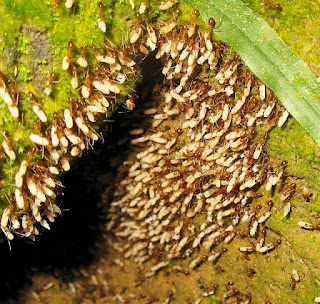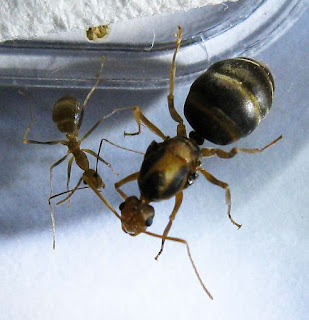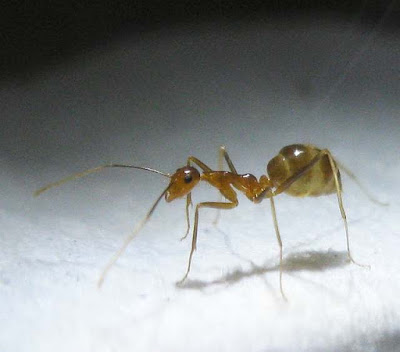Three main genera of crazy ants are commonly found here while a fourth, Tapinoma, though nonetheless just as crazy is not listed as such.
Anoplolepis gracilipes is the yellow crazy ants whose “super” colonies in the Christmas island were credited with almost wiping out the red land crabs there. It was recorded that these actually originated from the African continent (unconfirmed). Though found in abundance here especially in areas where there are human activities relating to agriculture or even in some cases residential, they have not attained the major invasive species title here, but found their niche in location where there is an absent of certain local ant species which seem to substantially affect their proliferation. They are typically the very first of ants species to colonized newly cleared jungle or wooded land that have been opened up either for development or agriculture.
Paratrechina longicornis a small black ant that is a major pest in homes and gardens where they have little competition from other ants that are fast enough to keep them in check. Their main strength is their moving (running) speed that allows them to elude the attacks of more formidable and more heavily equipped ants such as Pheidole, Pheidologetons and Solenopsis. Their main defense when their nest is invaded is to flee to a new location with their brood. This strategy however does not work when confronted by the larger crazy ant Anoplolepis gracilipes (one of their main predator) who can match them for speed and easily pick them off. Paratrechina are not entirely defenseless and frequently attack lone ants of around their size and smaller. They also attack large arthropods that are weaken either by injuries or other factors. This they frequently do by biting and ‘stinging’ the legs and antennae of their target. This manner of attack is quite similarly deployed by the larger crazy ant Anoplolepis gracilipes which also sprays formic acid at its prey.
Nylanderia is another mostly small species of crazy ants of around 2 to 3 millimeters in total length. This genus has the largest number of species but none of them (in this location) are serious pest unlike Anoplolepis gracilipes and Paratrechina longicornis. Though common in rural and suburban gardens as well as heavily planted parks, Nylanderia seldom find their ways into homes unlike their pesky cousin Paratrechina longicornis.
Tapinoma is an infamous pest ant mainly due to one member of this genus, Tapinoma melanocephalum. Most species of this genus are small ants of 2 millimeters and lesser in total length. Commonly known as ‘ghost ant’ (also in some areas as ‘sweat ants’ because of a smell they give off when crushed), Tapinoma melanocephalum however is not the only member of this genus that have made it nests in the homes of human. Scientifically classified as tramp ants according to their valuation as a species of no economic value.
All four of the above mentioned species are polygynous and monomorphic.Nylanderia is another mostly small species of crazy ants of around 2 to 3 millimeters in total length. This genus has the largest number of species but none of them (in this location) are serious pest unlike Anoplolepis gracilipes and Paratrechina longicornis. Though common in rural and suburban gardens as well as heavily planted parks, Nylanderia seldom find their ways into homes unlike their pesky cousin Paratrechina longicornis.
Tapinoma is an infamous pest ant mainly due to one member of this genus, Tapinoma melanocephalum. Most species of this genus are small ants of 2 millimeters and lesser in total length. Commonly known as ‘ghost ant’ (also in some areas as ‘sweat ants’ because of a smell they give off when crushed), Tapinoma melanocephalum however is not the only member of this genus that have made it nests in the homes of human. Scientifically classified as tramp ants according to their valuation as a species of no economic value.
Queen of Anoplolepis gracilipes. Anoplolepis and also Paratrechina longicornis are ground surface ants that prefers a dryer nest conditions. They typically nest under leave and plant (fallen tree trunks and branches, in hollows of any kind) litter cover and never deep into the ground unless the conditions are very dry. They are no diggers and do not dig ground tunnels and cravens.
Gyne of Anoplolepis gracilipes.
Nest of Anoplolepis gracilipes.
Temporary nest of Anoplolepis gracilipes.
Closer look at the nest of Anoplolepis gracilipes.
A closer look at the nest with eggs, larvae and pupae resting openly on top of leaves after a night of rain.
The Anoplolepis gracilipes gyne.
The Anoplolepis gracilipes gyne.
The Anoplolepis gracilipes gyne.
The queen of the yellow crazy ant Anoplolepis gracilipes with a worker.
Anoplolepis gracilipes worker with a queen.
Anoplolepis gracilipes worker
Workers of Anoplolepis gracilipes are monomorphic.
Anoplolepis gracilipes worker.
Anoplolepis gracilipes worker
Anoplolepis gracilipes worker
Anoplolepis gracilipes worker
Anoplolepis gracilipes worker
The alate gyne of Anoplolepis gracilipes.
An eclosing alate gyne of Anoplolepis gracilipes.

This small cricket is commonly found in nest of Anoplolepis gracilipes, as also are some species of small cockroaches. A similar looking but smaller species (see photo below of both) is also found in the nest of Paratrechina longicornis. While the large is accepted by Anoplolepis gracilipes as a nest mate, the smaller is not. Similarly the smaller is accepted by Paratrechina longicornis but the larger species is not.
Workers of Paratrechina longicornis.
Mortal enemies. Paratrechina longicornis workers attacking an Anoplolepis gracilipes worker that had strayed into their nest area. Generally Anoplolepis gracilipes will wipe out all Paratrechina longicornis ants in its foraging territory being equally fast and much larger than the black crazy ant.
The so called ant loving cricket. This is a small species of commensalistic cricket that is found among Paratrechina longicornis. It is basically a free loader living among this species of ants for food, shelter and security, and helping itself to the food that the ants bring home as well as being fed by the ants. A larger species is commonly found among Anoplolepis gracilipes the yellow crazy ants.
Major and minor workers of Euprenolepis procera.
Median and minor workers of Euprenolepis procera.
Workers and brood of Nylanderia sp.
Workers and brood of Paratrechina sp.
This maybe the only known species of the Paratrechina genus with dimorphic workers. See more of this species in the post Paratrechina sp.
Worker of Tapinoma melanocephalum.
Gyne and workers of Tapinoma melanocephalum.
See also other crazy ants:
Paratrechina longicornis
Taxonomy:
No rank: cellular organisms 131567
Superkingdom (Domain): Eukaryota 2759
No rank: Opisthokonta 33154
Kingdom: Metazoa 33208
No rank: Eumetazoa 6072
No rank (Subkingdom): Bilateria 33213
No rank (Branch): Protostomia 33317
No rank (Infrakingdom): Ecdysozoa
No rank (Superphylum): Panarthropoda 88770
Phylum: Arthropoda 6656
No rank (Subphylum): Mandibulata 197563
No rank: Pancrustacea 197562
Subphylum (Epiclass): Hexapoda 6960
Class: Insecta 50557
No rank (Subclass): Dicondylia 85512
Subclass (Infraclass): Pterygota 7496
Infraclass: Neoptera 33340
Cohort: Holometabola
Order: Hymenoptera 7399
Suborder Apocrita 7400
Infraorder: Aculeata 7434
Superfamily: Formicoidea
Family: Formicidae 36668
Subfamily - Formicinae
Tribe: Lasiini 72772
Genus - Anoplolepis 354295Species - gracilipes 354296
Updated: 2022 03 24
First Posted: 2009 09 14
© 2009 – 2022 Quah. All rights reserved.
































